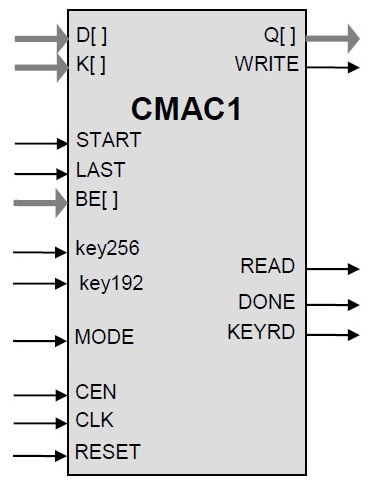|
|
CMAC1
CMAC and XCBC AES Core |
|
| |
General Description
The CMAC1 core provides implementation of cryptographic hashes AES-CMAC per NIST SP 800-38B and AES-XCBC. The cores utilize “flow-through” design that can be easily included into the data path of a communication system or connected to a microprocessor: the core reads the data via the D input, key from the K input and outputs the hash result via its Q output. Data bus widths for D, K, and Q are parameterized. The design is fully synchronous and is available in both source and netlist form.
|
|
Key Features
- Completely self-contained; does not require external memory
- CMAC algorithm per NIST SP800-38B and RFC 4493, AES-XCBC per CBC MAC submissions to NIST and RFC 3566.
- Supports 128, 192, and 256 bit AES keys.
- Flow-through design; flexible data bus width.
- Self-checking test bench provided
|
Applications
- Message digest calculation
- AES-CMAC-96
- AES-XCBC-96
- AES-CMAC-PRF-128
- AES-XCBC-PRF-128
- IPsec
- TLS
|
|
|
| |
Symbols

|
|
|
| |
Pin Description
| Name |
Type |
Description |
| CLK |
Input |
Core clock signal |
| Cen |
Input |
Synchronous enable signal. When LOW the core ignores all its inputs and all its outputs must be ignored. |
| START |
Input |
HIGH starting input data processing |
| READ |
Output |
Read request for the input data byte |
| DONE |
Output |
HIGH after the completion of the operation. Brought LOW by de-assertion of the start |
| RESET |
Input |
Asynchronous reset (for simulation purposes). Core will operate correctly if reset is never asserted. |
| LAST |
Input |
Marks the last byte of data |
| WRITE |
Output |
Write to the output interface |
| KEYRD |
Input |
Key read signal |
| MODE |
Input |
Mode of operation: LOW selects CMAC operation, HIGH – XCBC. Value on the mode input can only be changed while the start is low |
| D[ ] |
Input |
Input data |
| K[ ] |
Input |
Input Key |
| BE[ ] |
Input |
Specifies the number of bytes in the last word; unused if the input bus width is 8 bits |
| Q[ ] |
Output |
Output Hash Data |
| Key256 |
Input |
When HIGH, 256 bit AES key is used |
| Key192 |
Input |
When HIGH, 192 bit AES key is used |
|
|
| |
Function Description
The CMAC and XCBC algorithms process data in 128-bit blocks and produce message digests consisting of 128 bits and are defined in NIST SP 800-38B (http://csrc.nist.gov/publications/nistpubs/800-38B/SP_800-38B.pdf) and Black-Rogaway submission to NIST (http://www.cs.ucdavis.edu/~rogaway/papers/xcbc.pdf) together with RFC 3566.
The core is designed for flow-through operation, with I/O interface of parameterizable width. The input data can contain any number of bytes (data padding is performed inside the core). The output data is the 128-bit MAC value. |
|
| |
Throughput
The throughput of the core on long data packets depends on the core configuration and ranges
- from 0.8 bit to 12.8 bits per clock for the 128-bit key
- from 0.57 to 9.1 bits per clock for the 256-bit key
On short packets, performance is up to two times lower.
CMAC2 provides two times the performance of CMAC1 at the expense of larger size and lower maximum frequency. |
|
|
| |
| |
|